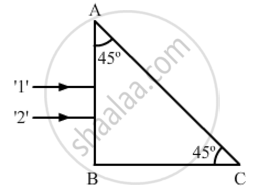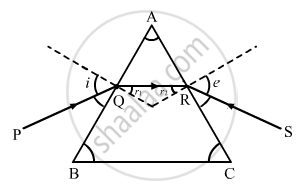Advertisements
Advertisements
Question
Two monochromatic rays of light are incident normally on the face AB of an isosceles right-angled prism ABC. The refractive indices of the glass prism for the two rays '1' and '2' are respectively 1.38 and 1.52. Trace the path of these rays after entering through the prism.

Solution
Critical angle of ray 1 is given by:
`sin(c_1)=1/mu_1=1/1.38`
`=>c_1=sin^(-1)(1/1.38)=46.44^@`
Similarly, critical angle of ray 2:
`sin(c_2)=1/mu_2=1/1.52`
`=>c_2=sin^(-1)(1/1.52)=41.14^@`
Both the rays will fall on the side AC with angle of incidence (i) equal to 45°. Critical angle for ray 1 is greater than that of i. Hence, it will emerge out from the prism as shown in the figure. Critical angle of ray 2 is less than that of i. Hence, it will get internally reflected as shown in the figure.

APPEARS IN
RELATED QUESTIONS
Plot a graph to show the variation of the angle of deviation as a function of the angle of incidence for light passing through a prism. Derive an expression for the refractive index of the prism in terms of angle of minimum deviation and angle of the prism.
Figure shows a ray of light passing through a prism. If the refracted ray QR is parallel to the base BC, show that (i) r1 = r2 = A/2 and (ii) angle of minimum deviation, Dm = 2i − A.

Can the dispersive power \[\omega = \frac{\mu_u - \mu_r}{\mu - 1}\] be negative? What is the sign of ω if a hollow prism is immersed into water?
A thin prism of angle 6.0°, ω = 0.07 and μy = 1.50 is combined with another thin prism having ω = 0.08 and μy = 1.60. The combination produces no deviation in the mean ray. (a) Find the angle of the second prism. (b) Find the net angular dispersion produced by the combination when a beam of white light passes through it. (c) If the prisms are similarly directed, what will be the deviation in the mean ray? (d) Find the angular dispersion in the situation described in (c).
The refractive index of a material M1 changes by 0.014 and that of another material M2 changes by 0.024 as the colour of the light is changed from red to violet. Two thin prisms, one made of M1(A = 5.3°) and the other made of M2(A = 3.7°) are combined with their refracting angles oppositely directed. (a) Find the angular dispersion produced by the combination. (b) The prisms are now combined with their refracting angles similarly directed. Find the angular dispersion produced by the combination.
A ray of light is incident on a prism whose refractive index is 1.52 at an angle of 40°. If the angle of emergence is 60°, calculate the angle of the prism.
Calculate dispersive power of a transparent material given : nv = 1.56, nr = 1.54, ny = 1.55.
How does the angle of minimum deviation of a glass prism vary if the incident violet light is replaced by red light?
The refractive indices of material for red, violet and yellow colour light are 1.52, 1.62 and 1.59 respectively.
Calculate the dispersive power of the material. If the mean deviation is 40°. What will be the angular dispersion produced by a prism of this material?
When a ray of white light is incident obliquely on the first surface of a prism, then ______.
